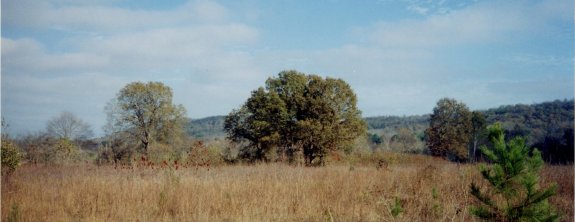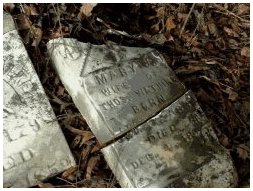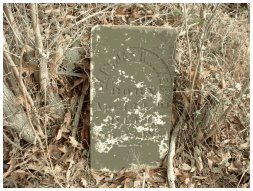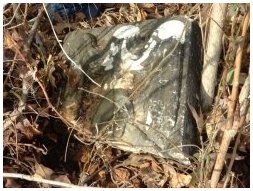

--Photo by Shelly Keech
The historic cemetery lies among this clump of trees on a private farm.
This old cemetery is located between El Paso and Floyd, 18 miles from Searcy. In addition to the county’s largest landowner of 1840 and other notables, it is believed that White County’s first judge and postmaster is buried here.
The following directions were provided by White County Historical Society member Shelly Keech, who visited the site in December 2000: "To reach the cemetery, at the intersection of highways 305 and 31 at Floyd, take El Paso Road. Follow the paved road until it becomes gravel. Keep going. Look to the left until you see a clump of trees. (They look like they were purposely left there...they were). The cemetery is inside of the trees. There is an older white frame house (the old Choate place) on the right." Keech was photographing the cemetery when she and family members were asked to leave because deer hunters were in the area. Leroy Blair, another Historical Society member, found a risk of another kind when he and his wife Ellen visited the site May 14, 2001. "I had on a light-colored shirt," he wrote in his report, "and when I got back to the car my shirt was almost black. I would guess we got well over 100 ticks off my shirt alone. I was covered in tick bites from head to toe." He said he would return in the fall when the leaves and ticks are gone. Blair could locate only two of the graves listed. He added the following to Shelly Keech’s directions: "As a reference point, on the right of El Paso Road, there is what looks like an old store building but is now a hunting club headquarters; the cemetery is directly across the road from this building, in the field about 300 yards, under the trees."
The late Donald Choate, who owned this farm, was a member of the Society and had provided information and assistance in researching this important historical site. By coincidence, Historical Society member Gerald Torrence was able to obtain the photographs at the bottom of this report about the time of Keech’s visit.
In 1964, the White County Historical Society published in its annual White County Heritage a list of five people who were buried on the Donald Choate farm at this location. They were the four Walkers and Mary J. Watkins. In May 2000, Historical Society member Mary Dean Reynolds provided documents indicating her great grandfather Jackson Price was also buried there. On June 18, 1968, Mrs. Reynolds wrote Choate the following: "In a recent conversation with my aunt, Mary Anne Carson, she told me of your finding the grave of Jackson Price," and asked him if he would send her information on the tombstone. Choate sent her a note that stated, "The stone says My Beloved Husband" and contained a drawing of two hands clasped together, along with Price’s birth and death dates. Choate also added, "I once sent in for his Civil War service record but they had ‘no record.’" Mrs. Reynolds stated May 18, 2000, that "Mrs. Choate [Donald’s widow] told me the marker had been destroyed by bush-hogging. I went to the spot she told me; only found a bed of iris. The land now belongs to the Choates’ son."

Articles in the 1964 edition of White County Heritage seem to indicate that Donald Choate found and reported the burial sites and even researched the Walker family. According to an article by Mrs. Lloyd Henry in the ’64 Heritage, Capt. James Walker served in the War of 1812 and came to White County prior to 1837. His son Crawford Walker, who is buried here, donated the 10-acre plot on which the City of Searcy was founded. Crawford died of cholera on the steamer Gov. Bent at age 31.
Writing in the 1984 edition of White County Heritage, W. Bruce Cook, director of information at Harding University, states that a post office was established in 1831 on the old Batesville-Little Rock military road at the crossing of Des Arc Creek, in what later became White County, and Lewis Kirkpatrick (1805-45) was appointed the first postmaster. Kirkpatrick, who came to the area in 1827 from Jackson County, TN, later became the first judge of White County, conducting the inaugural court session May 23, 1836. Citing a letter from a descendent of Kirkpatrick, Cook says "Relatives believe he is buried in the old Stamps Cemetery near Floyd."
Writing in the White County Historical Society newsletter in the spring of 2004, WCHS member Scott Akridge stated that in the first White County census, "James Walker owned the most land (nearly 1,000 acres) and had 11 slaves (23 slaves in the 1840 census). His property was located just south of Floyd in the area where Stamps Cemetery is today. Stamps Cemetery has been further investigated recently and is much larger than previously thought. I visited this cemetery with Bill Leach in January 2004 and we agreed that as many as 200 graves are located here. Walker himself is buried in this cemetery. The Walker farm is mentioned by G.W. Featherstonhaugh in his travels through Arkansas in 1834."
An article about the Stamps stagecoach house was published in the Arkansas Central Leader at McCrory in 1942. The author was Claude Johnson, a charter member of the White County Historical Society who served as president in 1971-72. Claude included this information: "Although the house is old, it faces a site much older, for the landscape contains a score or more of Indian mounds, indicating that the red men chose the site as their home also. These mounds are on a slope below the house and spring, and they cover several acres. In the center of the village stands the large chief mound, overlooking the rest." This was news to Scott Akridge, who is a former president of the Arkansas Archeological Society. "The description is not impossible," Akridge said, "but they were more likely natural high spots the Indians chose to live on. They then deposited more refuse over time and enlarged the 'mounds.' We call these house mounds. I have not seen any house mounds out there but agriculture could certainly have pulled them down. I have never been there when the fields were plowed. If some local persons had collections from the site involved, I could define the periods of occupation. If the old Stamps place sits on top of an Indian site it would not surprise me since early settlers often picked sites long occupied before. Where the Stamps house stood is on a natural high spot and the land slopes away toward creeks in all directions. A neat place since, were the land cleared for agriculture in say the 1850s, you could literally stand at the house and see for a good distance, thus keeping watch over all the farming operations."
There has been speculation that the Stamps Cemetery and a reported black cemetery nearby may mark the location of the lost Royal Colony and its "Royal Cemetery" which existed somewhere in this area before the Civil War. Historical Society members continue to research this enigma of early White County.
If you have corrections or additions to this list or other information on Stamps Cemetery, please contact the White County Historical Society, P.O. Box 537, Searcy, AR 72145.
Kirkpatrick, Lewis – 1805 – 1845 – unmarked – but relatives stated that he was buried here
Price, Jackson – March 10, 1846 – January 28, 1888
Walker, Capt. James – April 13, 1791 – January 28, 1852
Walker, Crawford – December 11, 1818 – March 25, 1849
Walker, Mary Mariah – April 30, 1798 – March 18, 1852

Walker, Nancy Bond (daughter of James & Mary M. Walker) – November 8, 1821 – September 19, 1841
Watkins, Mary J. (wife of Thomas Watkins) – October 3, 1831 – December 4, 1857

--photos courtesy Gerald Torrence
Stones of Mary Mariah (top to bottom), Capt. James Walker and a detached eagle lie hidden in the weeds and mostly forgotten in this historically significant cemetery.